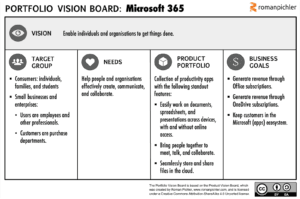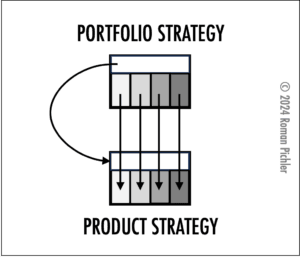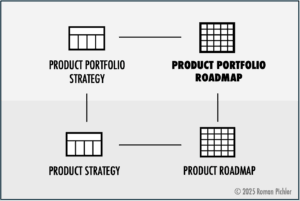Product portfolios, like Microsoft 365 and Adobe Creative Cloud, play an increasingly important role in value creation. But how can you capture the strategy of a product portfolio? Who should create it? What is the relationship between the portfolio and product strategy, and how often should it be reviewed? These are some of the portfolio questions that I am frequently asked, and that I answer in this article.
What is a product portfolio strategy?
A product portfolio strategy is a set of cohesive decisions that helps you maximise the value a group of products creates. You can think of it as a framework or guardrails that guide and align the strategies of the portfolio members.
Take Microsoft 365 as an example, Microsoft’s productivity tool suite. A portfolio strategy for the suite would guide the strategies of the individual products. Word, PowerPoint, and Excel would consequently implement the 365 strategy. Their visions, target groups, needs, standout features, and business goals would have to comply with the overall portfolio strategy.
For more information, see the article Everything You Need to Know about Product Portfolio Strategy.
Which information should the portfolio strategy contain?
An effective product portfolio strategy contains five elements—an overarching vision that describes the ultimate purpose of offering the portfolio; the markets and market segments the portfolio serves; the overall value it creates for the users and customers; the business benefits it helps achieve; and the type of products it contains with the capabilities that set them apart from competitors.
To make this more concrete, let’s see how the Microsoft 365 strategy might be captured using the canvas shown in Figure 1.
The structure in Figure 1 is based on the Product Vision Board—the tool I’ve developed to capture a product vision and a product strategy. You can therefore apply my strategy approach not only to individual products but also to a product portfolio. (Note that the sample strategy shown in Figure 1 is based on my research; it is not a description of the actual 365 strategy employed at Microsoft.)
But despite the structural similarity between a portfolio and a product strategy, there is an important difference: Due to its nature, a portfolio strategy has to be bigger and less specific than a product strategy—it covers several products and not just a single one. This means that its target group, needs, standout features, and business goals are significantly less specific than those in a product strategy.
For more guidance, refer to the articles Everything You Need to Know about Product Portfolio Strategy and The Product Vision Board.
Who creates the product portfolio strategy?
The product portfolio strategy is best created using a collaborative approach that involves the following individuals:
- The head of product, also referred to as Chief Product Officer and VP of Product Management, and/or a dedicated product portfolio manager.
- The product managers who are responsible for the products contained in the portfolio.
- Development team reps, who might include a UX designer (for end-user-facing products), an architect/programmer, and a tester/QA engineer.
- Key stakeholders, for example, a sales rep, a marketer, and a customer support team member.
This leverages the expertise of the individuals, creates clarity and alignment, and maximises the chances that people follow the strategy.
You can take this approach further and form a product portfolio team, which is similar to a product team, but operates at a higher level, as I explain in more detail in the article Everything You Need to Know about Product Portfolio Strategy.
Should I create a product portfolio strategy for a product bundle?
A product bundle consists of two or more products that are assembled into a single offering. Take Spotify, for example. At the time of writing, the app consists of music, podcasts, audiobooks, and courses, which might be marketed and sold as products in their own right. Spotify is therefore a product bundle, a composite product that is made up of several smaller products.
If you manage a product bundle, you are likely to benefit from using a product bundle strategy as well as strategies for the individual products the offering contains. The bundle strategy does the same job as a portfolio strategy, and you can use the same approach and template as described above. In the case of Spotify, an overall Spotify strategy would guide the music, podcasts, audiobooks, and courses strategies.
How does the portfolio strategy direct the product strategies?
The product portfolio strategy guides the product strategies in the following way:
- The product visions have to be aligned with and help fulfil the portfolio vision. Alternatively, the product visions might be identical to the portfolio one. This can be especially useful in the case of a cohesive portfolio, which is also referred to as a product family or suite.
- The target groups of the product strategies have to be subsets of the group addressed by the portfolio strategy.
- The needs captured in the individual strategies have to help meet the needs in the portfolio strategy.
- The standout features of the products have to support the ones in the portfolio strategy.
- The business goals in the product strategies have to help achieve the portfolio business goals.
Figure 2 illustrates this relationship.
Following this approach ensures that the portfolio and product strategies are closely aligned. To put it differently, the portfolio strategy sets the stage for the product strategies; it guides and constrains the strategic decisions of the portfolio members.
For more guidance, refer to the article Everything You Need to Know about Product Portfolio Strategy.
How is the product portfolio strategy implemented?
A great way to describe how a portfolio strategy should be implemented is to use a portfolio roadmap. Such a plan translates the strategy into outcomes that the portfolio should create. Figure 3 illustrates this relationship.
Additionally, Figure 3 shows the relationship between the portfolio roadmap and product roadmap. The latter is no longer exclusively guided by the product strategy. It is now also influenced by the portfolio roadmap. To put it differently, if you use a portfolio roadmap, your product roadmaps will have to follow it and comply with its outcomes.
To learn more about product portfolio roadmaps and how you can use them, refer to the article Succeeding with Product Portfolio Roadmaps.
How often should the product portfolio strategy be reviewed?
As a rule of thumb, I recommend reviewing the product portfolio strategy once per quarter. Consider the portfolio performance, changes in the competitive landscape and business strategy, new trends, and modifications of the strategies of the portfolio members. A great way to review and update the strategy is to follow a collaborative approach and involve the same individuals who helped create it. This reinforces a joint commitment and avoids handoffs and loss of knowledge.
The portfolio strategy is therefore far from being a fixed plan. Just like a product strategy, it is best understood as being adaptive. As Dwight D. Eisenhower famously said, “Plans are nothing; planning is everything.”
How do product portfolio strategy and product portfolio management relate?
As its name suggests, product portfolio management is the process of managing a group of products. This includes analysing a product portfolio using a tool like the Product Portfolio Matrix, creating and updating a product portfolio strategy, and adjusting the portfolio. The latter includes harmonising the strategies and roadmaps of the portfolio members, resolving dependencies, coordinating major releases (if required), as well as adding and removing products.
As this brief description shows, simply creating a product portfolio strategy is not enough. You also have to establish an effective portfolio management approach. To learn more, read the articles The Product Portfolio Matrix and The Innovation Ambition Matrix.
What are common product portfolio strategy mistakes to avoid?
- Not employing a product portfolio strategy despite having a product portfolio or bundle.
- Confusing portfolio and product strategy and not clearly differentiating them.
- Not effectively aligning the product portfolio strategy with the business and product strategy.
- Not regularly reviewing and adapting the portfolio strategy.
- Lacking an effective overall product portfolio management approach.




Post a Comment or Ask a Question